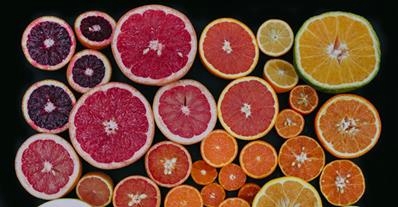
A tree's heat requirement is the number of hours it needs between bloom and maturity at a temperature above 55°F. ‘Washington' oranges, for example, need 8,000 hours. Perhaps more important, you need to consider the cold hardiness of your choice. Popular citrus, in order of most hardy to least hardy, would include mandarin orange, sweet orange, grapefruit, lemon and lime.
If your property experiences frost, one strategy is selecting a citrus variety that ripens early. 'Satsuma' mandarins are the most cold-hardy citrus and the earliest bearer. They do well in areas that are normally too cold for citrus, and the foliage survives temperatures down to about 22°F.
Spring is the best time to plant citrus in Napa County, after the threat of frost has passed. This schedule gives the tree's roots time to establish before the onset of cold weather. Choose your site carefully, preferably a protected area away from wind with at least six hours of sun each day. When the winter sun is low in the southern sky, the tree will appreciate placement near a sidewalk or wall that radiates heat.
Mulching around your citrus in winter may not be a good idea. Research shows that the soil retains more heat when allowed to absorb daylight sun. Replenish your mulch in the spring.
Cold air flows downhill, so avoid siting your tree in a low spot or on top of a windy hill. You can also protect your tree from wind by espaliering it against a wall or fence. Citrus trees can also be planted in containers that can be moved to a warm spot in winter, but pots are a temporary arrangement. Your citrus tree will need a larger pot every couple of years.
Fertilize mature citrus with nitrogen monthly from April through August. Feed from November through January with a citrus fertilizer, such as 0-10-10. Trees in containers require less fertilizer. Citrus occasionally suffer from a deficiency of micronutrients, such as zinc or iron. As new growth emerges in spring, add zinc or iron sulfate to the soil or try a foliar application of chelated zinc or iron. Iron will increase the juiciness and size of the fruit.
Maintaining a good fertilizing program helps your tree resist fungal diseases. However, over fertilizing will produce excessive foliar growth, making the tree susceptible to other disorders such as bacterial blast. Use insecticidal soap against the common insects that tend to bother citrus, such as scale, leaf miners and mites. Blast aphids with a strong spray of water.
When cold weather arrives, be ready for frost protection. A citrus tree's tolerance for frost is related not only to variety, but also to maturity and the level of hardening it has experienced. Young trees are especially vulnerable. The amount of damage a tree and its fruit suffer depends on the length of time the temperature remains at or below the threshold for that variety.
For example, if the temperature remains at 25°F for four to five hours, 60 percent of the fruit may freeze. Ripe oranges, grapefruits and mandarins start to freeze at 27°F to 28°F and lemons at 29°F to 30°F. With this information in mind, you can understand the value of frost-protection fabric, which affords a few degrees of protection. I have seen homeowners in Napa who have risen to the challenge, devising tenting that is practically an art form.
Water your tree before the temperature dips. A well-hydrated plant is more capable of withstanding frost damage because moist soils hold heat better. Outdoor tree lights (not LEDs)can be wrapped around your tree to provide extra warmth. Wait until spring to prune any frozen limbs.
Free workshops: Napa County Master Gardeners will lead a workshop on “Soils, Mulches & More” on Monday, September 29, from 6:30 p.m. to 8:30 p.m., at the Yountville Community Hall, 6516 Washington Street, Yountville. Learn the importance of soils, amendments and mulching. Understand basic landscape design and plant grouping. Napa County Master Gardeners will assist with another workshop on “Perfect Plant Picks” on Monday, October 6, from 6:30 p.m. to 8:30 p.m. in the same location. See how a drought-tolerant garden can be colorful and beautiful. Dozens of plants will be on display, including California natives. Both workshops are free but registration is required. To register, call 707-252-4188 X116 or e-mail frances@naparcd.org.
Workshop: Napa County Master Gardeners will lead a workshop titled “Be Successful with Citrus” on Saturday, October 11, at the American Canyon Senior Multi-Use Center, 2185 Elliiott Drive, American Canyon and on Saturday, October 18 in Calistoga at the Community Room, 1307 Washington St. Both workshops are from 9:30-11:30. Get the information you need to succeed with your new or mature citrus trees. Learn about choosing varieties, planting, fertilizing and protecting from frost.Online registration (credit card only); Mail-in registration (cash or check only).The workshop will be repeated on Saturday, October 18, from 9:30 am to 11:30 am. Register online for the Calistoga workshop.
Master Gardeners are volunteers who help the University of California reach the gardening public with home gardening information. Napa County Master Gardeners ( http://ucanr.org/ucmgnapa/) are available to answer gardening questions in person or by phone, Monday, Wednesday and Friday, 9 a.m. to Noon, at the U. C. Cooperative Extension office, 1710 Soscol Avenue, Suite 4, Napa, 707-253-4143, or from outside City of Napa toll-free at 877-279-3065. Or e-mail your garden questions by following the guidelines on our web site. Click on Napa, then on Have Garden Questions? Find us on Facebook under UC Master Gardeners of Napa County.